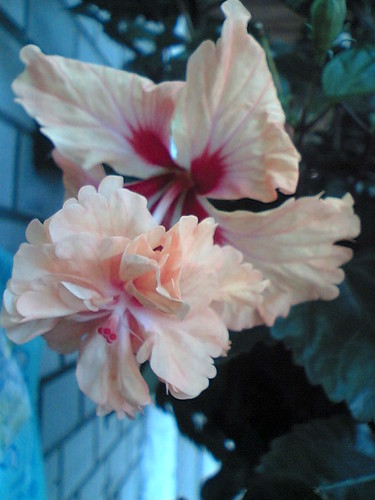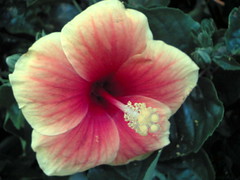The flowers above are known as Yae-haibisukasu here, yae means double.
I thought the structure of the flower was interesting. Side view below
Hibiscuses are as ubiquitous in Okinawa as they are in Hawaii. They are known there as the akabanaa or the Red Flower. However, they are generally popular summer garden plants in the rest of Japan.
Hibiscuses are popular additions to any garden in summer, and can provide colour when the heat sends the garden into a green spell.
Here’s something on the history of the Hibiscus:
Hibiscus is an ancient Greek and Latin name. It is also commonly known as the Rose of China, China Rose, the Rose of a Day and Shoe Black Plant. The most commonly grown species, is the Hibiscus rosa-sinensis which means “Chinese rose”.
Little is known about the early history of tropical hibiscus. The species is unknown in the wild and its area of origin is conjectural. Also known as the Chinese hibiscus, the plant commonly recognized as the Hibiscus (rosa-sinensis) is widely thought to be a native of warm southern China that made its way through the islands of the South Pacific to Hawaii. Most of the plants produced today originate from the single species rosa-sinensis. It is said that the original wild flower was a small single pink one that possibly no longer exists. It is also widely thought that the plant might have been a native of continental tropical Asia, being the most popular and widely planted shrub of the tropics. They appear to be tropical flowers. They need a steady supply of moisture and are not fond of drying out and tend to grow in wet or swampy areas. One popular ornamental family member that is more cold-hardy than most is the rose-of-sharon (shrubby althea). A few species, like okra, can be eaten, and cotton provides one of the world’s most popular clothing fibers. Some types hibiscus have been used to make dyes.
Facts about the plant:
The largest group of plants in the Malvaceae (mallow) family is the genus Hibiscus. Hibiscus plants are known for their large, showy flowers with deep-colored bases. The plants range from low, spreading forms to upright varieties reaching 20 feet in height. Some are compact and dense while others are open and thin. The flowers can vary in size from blossoms two inches in diameter up to 12 inches, with colors ranging from white to purple. The flowers of most varieties last only a day, with the blossoms opening early in the morning and wilting by late afternoon; however, the flowers of a few varieties remain open for two days. Most hibiscus are odorless, but some of the basic varieties have a modest fragrance.
All of the astounding variety of hibiscus cultivars have been established by plant breeders. Most hibiscus varieties have been developed for a particular growth habit, size, shape and color of flower, and the ability to adapt to specific environmental conditions. Although the six basic colors are red, orange, yellow, white, lavender, and brown, breeding has created a wide range of color combinations and shades, and flower forms. Hibiscus flowers are basically characterized as single or double forms with variations in the number and arrangement of petals. Flowers that have been picked from the plant don’t need any water, but, if they’re going to used in the evening, should be refrigerated until it’s time to display them. Hibiscus are used in the landscape as informal hedges or screens, background or foundation plants, usually in a mass planting of a single variety. Selected varieties, called “standards,” may be trained to grow with a single trunk and are often used as attractive specimen plants for patios, terraces, and flower gardens. Single blooms typically have five petals, five stigma pads, a five cell ovary, five teeth on the calyx, and five to ten bracts. The full and crested double blooms are identical but have more than five petals. With proper care the plant can bloom continuously throughout the year. In areas that are subject to frost, hibiscus can be grown in pots and brought inside for the winter. Many of the basic, non-grafted varieties will come back from the roots if a frost kills the upper plant. When a hibiscus plant dries out to the point where the leaves wilt for more than one day, the leaves will dry up and fall off; however these leaves will grow back rapidly. Dropping leaves is a method the plants use to reduce moisture loss.
Many hibiscus aficionados increase the number of plants they have by using cuttings, a practice known as cloning or asexual reproduction. Select the best tips; look for good leaf color and a robust upright growing stance. Water the plants in the morning before taking the cuttings. Use sterilized shears. Count down about 4 leaf nodes to where the stem starts turning from light green to brown. Make each cut at a 45 degree angle just below a leaf node. Remove the lower leaves from the cutting, as well as any large top leaves. Dip the point of the cutting into a rooting stimulant, and then insert them into the growing medium only as deep as necessary to keep them upright. The cuttings should be fully rooted by the end of 6 weeks, and can then be transplanted. If the cuttings have been rooted in a green house, they should be hardened off before transplanting, by switching them to regular irrigation, and moving them out into the sunlight during the day, and back indoors for the night, for a few days.
However, another different view is that the Chinese hibiscus was from India and may have been hybrids of two or more species from areas near the Indian Ocean. This view is due to the fact that Polynesian people are supposed to have originated in India and may have brought the species to China and the Pacific in the centuries of their Eastern migrations. The common red single form of Hibiscus rosa-sinensis is also known as “common red” and is the national flower of Malaysia and the State of Hawaii.
The Chinese royal court’s search for new and different blooms began the development of what became thousands of varieties. And because it reached its highest development as an ornamental plant in China, the species was given its name rosa sinensis. Most cultivars were collected and shipped to Europe from there. By the time they were introduced into Europe in the 1700’s, they were in various colors and had changed character greatly from being just single blooms.
Hibiscus plants were introduced to the United States via Philadelphia, about 1842. Hibiscus hybrids provide a wide range of colors and flower styles, reds, yellows, pinks, orange, white, peach and blends of colors. There are also single and double flowers. These plants seem to have innumerable variations in color and shape in both single and double, and the hybridizing continues to this day, which add much to the joy and interest of hibiscus fanciers.
Flower uses:
In India, its flower, when crushed, turns black and yields a dark purplish dye used for blacking shoes, hence the nickname “Shoe Black Plant”. In parts of China it is used to dye hair. Hawaiians eat raw flowers to aid digestion and the Chinese pickle and eat them. And, in Tahitian lore, the hibiscus worn over the right ear shows that a person is looking for a mate, and if over the left ear, a mate has been found…….
Source: http://darwin.nmsu.edu/~molbio/plant/hibiscus.html; http://www.4hibiscus.com/html/history.html; and http://www.klahanie.ca/care.htm
Most hibiscuses are tropical plants that must be brought in before winter. I learned from my florist however, that there is a native Japanese hibiscus called fuyo that is a temperate flower that can survive winter well.









